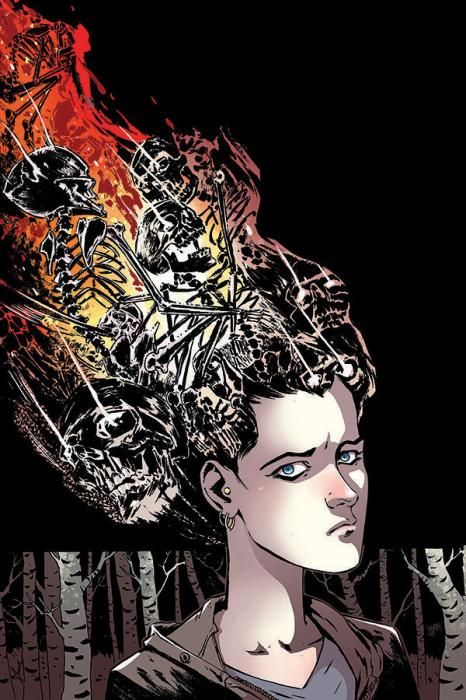In "Sheltered" #2 by Ed Brisson and Johnnie Christmas, Safe Haven resets after the massive cliffhanger of the debut issue. Although execution is more important than ideas, it's hard not to admire the morbid irony and wordplay of Brisson and Christmas' concept for "Sheltered." Safe Haven is a survivalist compound, isolated and self-sustaining, founded by a group that believes in preparing for any emergency from natural disaster to socio-political anarchy. All that planning, all that paranoia didn't shelter the forward-planning adults of Safe Haven from a threat from their own babes in the woods.
The concept is catchy, but the story is personal in scope, driven more by atmosphere and emotion than by its central conceit. It's also an inverted mystery -- not a whodunit, but the kind of setup that makes the reader terribly curious about the succession of past events and convoluted moral development that led up to Zero Hour in "Sheltered" #1.
From her first appearance on-panel, was clear that Victoria was going to be the point-of-view character. She and her dad were immediately likable in their close and affectionate relationship and both came off as intelligent and outspoken. As newcomer to the compound, Vic's reactions echo the average teenager's discontent with displacement and boredom. If this were the usual "new girl in town" story, Vic's friendship with Hailey would ease her into the social world of Safe Haven, and her tribulations would be limited to classes or bullies. Instead, in "Sheltered" #2, Vic and Hailey deal with mass murder in a situation in which there is no authority to which they can appeal for assistance or justice.
Brisson picks up the story right after the disturbing, well-executed last-panel cliffhanger of "Sheltered" #1, starting with Victoria and Hailey hearing gunshots. From there, the timeline is strictly linear as the fallout unfolds. Brisson's pacing is gratifying quick here. It would be easy for him to milk more suspense by needlessly dragging out the Big Secret and delaying confrontation scenes, but he is confident about sharing information at quick clip, preferring to center the suspense on an uncertain future.
Brisson's focus on Vic and her dad paid off in "Sheltered" #1 when her dad was snuffed, but in "Sheltered" #2, Vic's quick-to-action response is almost unrealistic in how she doesn't seem to need recovery time for shock or grief. That's when Hailey comes in handy as a foil to Vic. Hailey is slower to react, more cautious and more frightened. Another kid, Tab, also provides a good psychological touchpoint when she has hysterics. When Vic and Lucas face off, they fall into place as the larger-than-life villain and heroine of Safe Haven, but Brisson's larger ensemble cast keeps things closer to psychological realism.
Christmas' artwork makes budding cult leader Lucas' coup d'etat believable. All the characters have a distinctive look, and it's a feat that Christmas makes blond, unblemished, handsome, confident Lucas come off as unsettling and scary. He's a big dreamer, but not in a good way. Christmas' facial expressions are superb, conveying Lucas' instrumentalist, calculating manner perfectly. Lucas' expression as he regards the bonfire is eerie. In a later scene, when Lucas appears warm and empathetic as he tries to win Vic and Hailey over, the reader feels a chill witnessing the con game of a possible sociopath.
Christmas' depiction of bleak, snowy woods ties in with the tone of the story, and Chankhamma's cold palette complements this, amplifying the effect of claustrophobic isolation and quiet horror.
Brisson and Christmas are mining some fascinating themes here. "Sheltered" revolves around the boundary between Inside and Outside. It touches on community vs. isolation, moral absolutism vs. utilitarianism, peer group hierarchies, and the terrible power of a unifying obsession. A closed world is fascinating, but it will also be rewarding, later on, to see how Safe Haven will fare when it inevitably interfaces again with the outside world. It's not all at clear how things will turn out, and that is one of the primary attractions of "Sheltered." Psychological suspense is potent, and "Sheltered" #2 has plenty of it.

